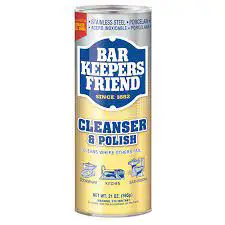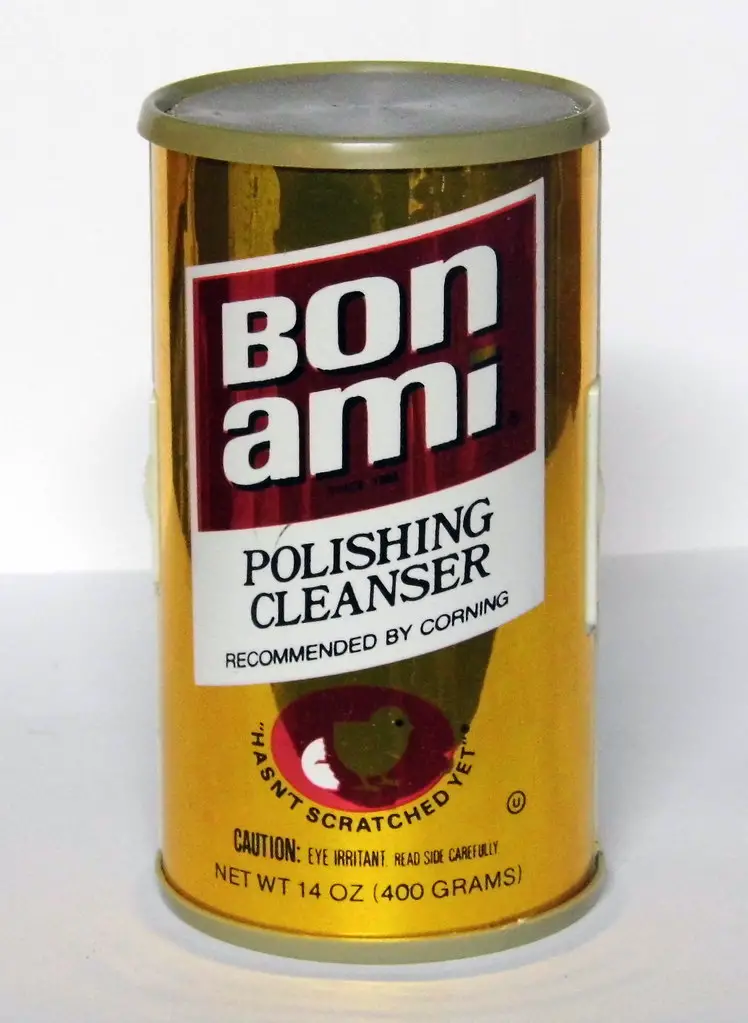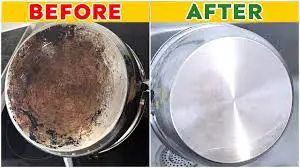Looking to keep your culinary arsenal in top-notch condition? One of the key areas that often requires special attention is the bottom of your pans.
Knowing how to clean the bottom of pans effectively can not only enhance the longevity of your cookware but also ensure the flavors of your culinary creations remain uncompromised.
In this comprehensive guide, we’ll delve into a treasure trove of effective and detailed techniques to ensure that your pans remain as good as new, ready to assist you in crafting culinary wonders for years to come.
It does not matter if you have used the pan for years in your indoor kitchen or have used it to prepare some cool meal when on your camping trip. Today, you will learn how to clean the bottom of your pans.
Importance of Cleaning the Bottom of Pans
When it comes to cooking, the bottom of your pans plays a critical role in ensuring the quality and flavor of your dishes. Neglecting proper cleaning can lead to an array of issues, including uneven heat distribution, altered flavors, and in some cases, even contamination.
Moreover, regular maintenance of your pan bottoms can significantly extend their lifespan, saving you the hassle and cost of frequent replacements.
Different Types of Pan Bottoms
Understanding the diverse nature of pan bottom materials is key to mastering effective cleaning techniques. Let’s take a closer look at each type and the specific care it demands:
Stainless Steel
Stainless steel pans are known for their durability and sleek appearance. However, they can be prone to discoloration and stubborn burnt-on residue.
To ensure the longevity of your stainless steel pans, you’ll need to employ careful and specific cleaning methods.
Copper
Copper pans, favored for their exceptional heat conductivity and elegant look, require special attention to maintain their trademark shine.
Understanding the best practices for cleaning copper bottoms is crucial in preserving their luster.
Aluminum
Aluminum pans are known for their lightweight yet robust construction, making them a popular choice for many home cooks.
However, they can be susceptible to stains and scratches if not handled with care. Employing the right cleaning approach can help retain their pristine condition.
Cast Iron
Cast iron pans are beloved for their exceptional heat retention and versatility, making them a favorite among seasoned chefs and home cooks.
However, their susceptibility to rust and the need for regular seasoning demand a unique cleaning approach.
Non-stick Coatings
Non-stick pans, cherished for their hassle-free cooking and cleaning features, require a delicate touch to ensure the longevity of their non-stick coating.
Implementing the correct cleaning methods can prolong their functional lifespan.
General Cleaning Techniques
While specific pans may require tailored cleaning methods, there are several general techniques that serve as a solid foundation for maintaining the cleanliness of your pan bottoms.
Let’s explore these techniques in detail:
1. Baking Soda and Vinegar Solution
- Step 1: Create a mixture of baking soda and vinegar in a bowl.
- Step 2: Apply the solution to the bottom of the pan, ensuring thorough coverage.
- Step 3: Let the solution sit for about 15-20 minutes to allow the ingredients to work on the grime.
- Step 4: Scrub the pan gently with a non-abrasive sponge or brush.
- Step 5: Rinse the pan thoroughly with water and dry it with a clean cloth.
2. Lemon and Salt Scrub
- Step 1: Cut a lemon in half and dip the exposed side in salt.
- Step 2: Use the salted lemon to scrub the bottom of the pan, focusing on areas with stubborn stains or residue.
- Step 3: Allow the lemon juice and salt to sit on the surface for a few minutes.
- Step 4: Scrub the pan gently with a soft-bristled brush or non-abrasive sponge.
- Step 5: Rinse the pan thoroughly with water and dry it with a clean cloth.
3. Boiling Water Method
- Step 1: Fill the pan with water and bring it to a boil.
- Step 2: Allow the water to boil for 5-10 minutes to loosen any stuck-on particles.
- Step 3: Remove the pan from the heat and let it cool down slightly.
- Step 4: Gently scrub the pan with a soft-bristled brush or non-abrasive sponge.
- Step 5: Rinse the pan thoroughly with water and dry it with a clean cloth.
Employing these general techniques can serve as effective preliminary steps in your pan cleaning routine, ensuring a solid foundation for more targeted methods based on the material of your pan bottom.
How to Clean Different Types of Pan Bottoms
Let’s explore the specific cleaning techniques for each type of pan bottom, ensuring that you handle your pans with the care they deserve.
Cleaning Stainless Steel Pan Bottoms
Stainless steel pans are renowned for their resilience and modern aesthetics, making them a staple in kitchens around the world.
However, their shiny exterior can often succumb to discoloration and burnt-on residue.
To ensure the effective cleaning of stainless steel pan bottoms, follow these steps:
- Use a Non-abrasive Cleaner
- Step 1: Choose a non-abrasive cleaner specifically formulated for stainless steel pans.
- Step 2: Apply the cleaner to the bottom of the pan and let it sit for a few minutes.
- Step 3: Gently scrub the pan with a soft-bristled brush or non-abrasive sponge.
- Step 4: Rinse the pan thoroughly with water to remove any residue from the cleaner.
- Step 5: Dry the pan with a clean cloth to prevent water spots or streaks.
- Stainless Steel Cleaner and Polish
- Step 1: Apply a small amount of stainless steel cleaner to the bottom of the pan.
- Step 2: Use a soft cloth to spread the cleaner evenly across the surface.
- Step 3: Let the cleaner sit for a few minutes to penetrate any stubborn stains or marks.
- Step 4: Gently buff the pan with a clean cloth to restore its original shine.
- Step 5: Wipe off any excess cleaner to prevent residue buildup.
Cleaning Copper Pan Bottoms
Copper pans are known for their exceptional heat conduction and elegant appearance, making them a favorite among professional chefs and cooking enthusiasts.
However, their tendency to tarnish and develop a patina demands special care during cleaning.
Follow these steps to maintain the striking luster of your copper pan bottoms:
- Lemon Juice and Salt
- Step 1: Squeeze fresh lemon juice into a bowl and add a generous amount of salt.
- Step 2: Mix the ingredients to create a thick paste.
- Step 3: Apply the paste to the bottom of the copper pan, ensuring even coverage.
- Step 4: Let the paste sit for a few minutes to allow the acidic properties of the lemon and the abrasive texture of the salt to work on the tarnish.
- Step 5: Gently scrub the pan with a soft-bristled brush or non-abrasive sponge.
- Step 6: Rinse the pan thoroughly with water to remove any residue from the paste.
- Step 7: Dry the pan with a clean cloth, ensuring that no water spots or streaks remain.
- Copper Cleaner Paste
- Step 1: Apply a small amount of copper cleaner paste to the bottom of the pan.
- Step 2: Use a soft cloth to spread the paste evenly across the surface, focusing on areas with tarnish or stubborn stains.
- Step 3: Let the paste sit for a few minutes to allow the active ingredients to penetrate the tarnished surface.
- Step 4: Gently buff the pan with a clean cloth, applying slight pressure to remove any remaining tarnish or stains.
- Step 5: Wipe off any excess paste to prevent residue buildup and ensure a polished finish.
Cleaning Aluminum Pan Bottoms
Aluminum pans are known for their lightweight yet robust construction, making them a popular choice for many home cooks.
However, they can be susceptible to stains and scratches if not handled with care.
Follow these steps to preserve the pristine condition of your aluminum pan bottoms:
- Cream of Tartar Paste
- Step 1: Combine cream of tartar and water in a bowl to create a thick paste.
- Step 2: Apply the paste to the bottom of the aluminum pan, ensuring even coverage.
- Step 3: Let the paste sit for a few minutes to allow the mild abrasives to work on the stains.
- Step 4: Gently scrub the pan with a soft-bristled brush or non-abrasive sponge.
- Step 5: Rinse the pan thoroughly with water to remove any residue from the paste.
- Step 6: Dry the pan with a clean cloth, ensuring no water spots or streaks remain.
- Aluminum-Friendly Cleaning Agents
- Step 1: Choose a cleaning agent specifically formulated for aluminum cookware.
- Step 2: Apply the cleaning agent to the bottom of the pan and let it sit for a few minutes.
- Step 3: Gently scrub the pan with a soft-bristled brush or non-abrasive sponge, focusing on areas with stains or grime.
- Step 4: Rinse the pan thoroughly with water to remove any residue from the cleaning agent.
- Step 5: Dry the pan with a clean cloth, ensuring a smooth and spotless finish.
Cleaning Cast Iron Pan Bottoms
Cast iron pans are beloved for their exceptional heat retention and versatility, making them a favorite among seasoned chefs and home cooks.
However, their susceptibility to rust and the need for regular seasoning demand a unique cleaning approach.
Follow these steps to clean your cast iron pan bottoms effectively:
- Salt Scrub
- Step 1: Sprinkle a generous amount of salt on the bottom of the cast iron pan.
- Step 2: Use a soft-bristled brush or non-abrasive sponge to scrub the pan, focusing on areas with stubborn residue.
- Step 3: Rinse the pan thoroughly with water to remove any loosened particles.
- Step 4: Dry the pan with a clean cloth, ensuring that no moisture remains on the surface.
- Step 5: Apply a thin layer of cooking oil to the pan to prevent rust and maintain its non-stick properties.
- Seasoning with Cooking Oil
- Step 1: Pour a small amount of cooking oil onto the bottom of the pan.
- Step 2: Use a clean cloth to spread the oil evenly across the surface, ensuring complete coverage.
- Step 3: Heat the pan over low heat to allow the oil to penetrate the surface and create a protective layer.
- Step 4: Let the pan cool down and remove any excess oil with a clean cloth.
- Step 5: Store the pan in a dry place to prevent the formation of rust and maintain its seasoning.
Cleaning Non-stick Coated Pan Bottoms
Non-stick pans have revolutionized the cooking experience, making it easier to prepare a wide array of dishes without the hassle of stubborn residue or sticking food.
However, their delicate non-stick coating requires gentle handling to ensure longevity.
Follow these steps to preserve the non-stick properties of your pan bottoms:
- Mild Dish Soap and Warm Water
- Step 1: Fill the sink with warm water and add a few drops of mild dish soap.
- Step 2: Submerge the non-stick pan in the soapy water and let it soak for a few minutes.
- Step 3: Gently scrub the pan with a non-abrasive sponge, ensuring that you don’t use any harsh or abrasive materials that could damage the non-stick coating.
- Step 4: Rinse the pan thoroughly with water to remove any soapy residue.
- Step 5: Dry the pan with a clean cloth, ensuring no moisture remains on the surface.
- Non-abrasive Sponges or Cloths
- Step 1: Dampen a non-abrasive sponge or soft cloth with warm water.
- Step 2: Gently scrub the bottom of the pan, focusing on areas with stubborn residue.
- Step 3: Rinse the pan thoroughly with water to remove any loosened particles.
- Step 4: Dry the pan with a clean cloth, ensuring a smooth and dry finish.
- Step 5: Store the pan in a cool, dry place to prevent any damage to the non-stick coating.
Comparison of Different Types of Pan Bottoms
| Type of Pan Bottom | Characteristics | Cleaning Method |
|---|---|---|
| Stainless Steel | Durable and sleek appearance, prone to discoloration and burnt-on residue | Use non-abrasive cleaner or stainless steel cleaner and polish |
| Copper | Excellent heat conductivity, elegant appearance, prone to tarnishing and patina | Clean with lemon juice and salt or copper cleaner paste |
| Aluminum | Lightweight yet robust, susceptible to stains and scratches | Apply cream of tartar paste or use aluminum-friendly cleaning agents |
| Cast Iron | Exceptional heat retention, requires regular seasoning, susceptible to rust | Scrub with salt and season with cooking oil regularly |
| Non-stick Coatings | Hassle-free cooking and cleaning, delicate non-stick coating | Clean with mild dish soap and warm water; avoid abrasive materials |
Using this table as a reference, you can easily compare the different types of pan bottoms and their respective cleaning methods, allowing you to choose the most suitable approach for your specific cookware.
Prevention Tips for Maintaining Clean Pan Bottoms
While effective cleaning methods are vital for restoring the shine of your pan bottoms, implementing preventive measures can significantly reduce the frequency of rigorous cleaning sessions.
Consider the following proactive tips to maintain clean and spotless pan bottoms:
- Seasoning your Pans Regularly: Regularly seasoning your pans, especially cast iron ones, helps create a protective layer that prevents stubborn stains from adhering to the pan bottom.
- Using Appropriate Cooking Utensils: Opt for utensils that are compatible with the surface of your pans to prevent scratches and damage during cooking and cleaning.
- Avoiding High Heat for Prolonged Periods: Exposing your pans to excessively high temperatures for extended periods can lead to discoloration and stubborn residue, making cleaning more challenging. Moderate and consistent heat levels ensure even cooking and facilitate easier cleaning.
By incorporating these preventive measures into your kitchen routine, you can prolong the cleanliness and quality of your pan bottoms, ensuring a seamless cooking experience for years to come.
Recommended Cleaning Products
Using the right cleaning products can streamline the cleaning process and ensure that your pan bottoms remain spotless and free from stubborn grime.
Consider the following highly recommended products to maintain the cleanliness of your pans:
| Product Name | Description |
|---|---|
| Bar Keepers Friend | A versatile cleaner suitable for various types of pans, offering effective stain removal and restoration of shine. |
| Bon Ami | A gentle yet powerful cleaner is perfect for removing tough stains without causing damage to delicate pan surfaces. |
| Brillo Pads | Highly effective in tackling tough stains and grime, these pads are ideal for deep cleaning without leaving scratches on the pan bottom. |



FAQs
How to choose the right cleaning method for different types of pan bottoms?
Understanding the specific material of your pan bottom is crucial in selecting an appropriate cleaning method that effectively removes grime without causing damage.
What are some natural cleaning solutions for stubborn stains on pan bottoms?
Natural solutions like baking soda, vinegar, lemon, and salt can work wonders in tackling tough stains without the use of harsh chemicals, ensuring a safe and eco-friendly cleaning process.
Is it safe to use abrasive materials on pan bottoms for deep cleaning?
While some pan bottoms may withstand light abrasion, it’s generally safer to avoid abrasive materials to prevent scratches and damage, especially for delicate surfaces like non-stick coatings and copper bottoms.
How often should I clean the bottom of my pans?
Regular maintenance is key to preserving the quality of your pan bottoms. Aim to clean your pans after each use, especially if there are visible stains or residue that could compromise their cooking performance.
Are there any preventive measures to minimize stubborn residue buildup on pan bottoms?
Implementing proactive steps like using appropriate cooking utensils, avoiding high heat for extended periods, and seasoning your pans regularly can significantly reduce the accumulation of stubborn residue, making the cleaning process more manageable.
What are the signs that indicate it’s time to replace a pan?
Signs such as severe warping, extensive rust, or irreversible damage to the non-stick coating indicate that it may be time to replace your pan. Regular maintenance can prolong its lifespan, but certain damages may be beyond repair.
How can I ensure the longevity of my pans after cleaning?
Proper storage in a dry place, using protective pads or liners when stacking pans, and avoiding exposure to extreme temperatures or direct flames can contribute to the long-term durability and functionality of your pans post-cleaning.
How to clean burnt grease from the bottom of frying pans?
A mixture of baking soda and vinegar can be effective in tackling burnt grease. Create a paste with baking soda and vinegar, apply it to the affected area, let it sit for a while, and then scrub gently with a non-abrasive sponge or brush to remove the burnt grease.
How to clean the bottom of pans with baking soda and vinegar?
Baking soda and vinegar can form a powerful cleaning solution when combined. Create a paste using baking soda and vinegar, apply it to the bottom of the pans, let it sit for some time, and then scrub gently with a sponge or brush to remove stubborn stains and residue.
How to clean the bottom of pans with vinegar?
Vinegar can be an effective natural cleaner for pan bottoms. Mix vinegar with water, apply the solution to the bottom of the pans, let it sit for a while to break down any grime, and then scrub gently with a non-abrasive sponge to restore the pan’s cleanliness and shine.
How to clean the outside of pots and pans to look like new?
To restore the exterior of pots and pans, use a mixture of baking soda and water to create a paste. Apply the paste to the outside surface, let it sit for some time, then scrub gently with a sponge or brush to remove any stains or discoloration, revealing a refreshed and polished exterior.
How to clean the outside bottom of a pan TikTok?
Some TikTok users recommend using a mixture of baking soda and water or vinegar to clean the outside bottom of pans. Apply the solution to the affected area, let it sit for a while, and then scrub gently with a sponge or brush to achieve a clean and shiny pan bottom.
How to clean burnt pan bottoms?
Removing burnt residue from pan bottoms can be achieved by using a combination of baking soda and vinegar. Create a paste, apply it to the affected area, let it sit for a while, and then scrub gently with a non-abrasive sponge to lift off the burnt residue and restore the pan bottom.
How to clean the bottom of pans with ketchup?
Ketchup’s acidic properties make it an effective cleaner for pan bottoms. Apply a layer of ketchup to the affected area, let it sit for a while, and then scrub gently with a sponge or brush. The acidic components of the ketchup can help break down stubborn stains and residue.
How do you get brown stains off the bottom of a pan?
A mixture of baking soda and water can work wonders in removing brown stains from pan bottoms. Create a paste, apply it to the stains, let it sit for some time, and then scrub gently with a sponge or brush. The abrasive properties of baking soda help to lift off the brown stains effectively.
How do you get burnt oil off a pan?
To remove burnt oil from a pan, use a mixture of baking soda and vinegar. Create a paste, apply it to the affected area, let it sit for a while, and then scrub gently with a non-abrasive sponge. The combination of baking soda and vinegar helps to break down and lift off the burnt oil residue.
How do you deep clean a dirty pan?
For a thorough deep clean of a dirty pan, consider using a combination of baking soda and vinegar. Create a paste, apply it to the pan’s surface, let it sit for some time, and then scrub gently with a sponge or brush. The bubbling action of the baking soda and vinegar helps to dislodge and lift off stubborn grime and dirt.
How do you clean under pans with baking soda?
Cleaning the underside of pans with baking soda is simple. Create a paste using baking soda and water, apply it to the underside, let it sit for some time, and then scrub gently with a sponge or brush. The abrasive nature of baking soda helps to remove any accumulated residue and grime.
Conclusion
In the bustling world of culinary adventures, a well-maintained pan is a chef’s best friend.
Ensuring that the bottom of your pans remains immaculate is not just about aesthetics but also about optimizing the cooking process and preserving the flavors of your delectable creations.
With the detailed techniques and preventive tips outlined in this comprehensive guide, you are well-equipped to conquer any cleaning challenge and preserve the shine and longevity of your cherished cookware.
So roll up your sleeves, choose the right cleaning arsenal, and embark on the journey to a kitchen where every pan bottom glistens with pride and functionality.
Happy cooking.
References
- https://www.bobvila.com/articles/how-to-clean-cookie-sheets/
- https://www.southernliving.com/food/kitchen-assistant/how-to-clean-burnt-pan-hydrogen-peroxide-baking-soda
- https://www.nytimes.com/wirecutter/guides/how-to-clean-stainless-steel-pans/
- https://www.epicurious.com/expert-advice/how-to-clean-the-dirtiest-pan-skillet-steel-wool-baking-soda-article
- https://www.nytimes.com/wirecutter/guides/how-to-clean-stainless-steel-pans/
- https://www.epicurious.com/expert-advice/how-to-clean-the-dirtiest-pan-skillet-steel-wool-baking-soda-article



